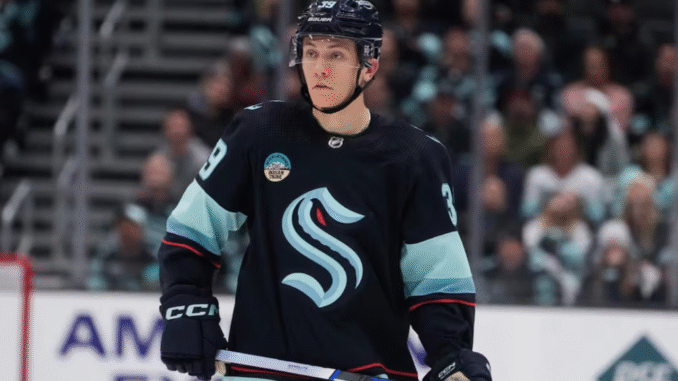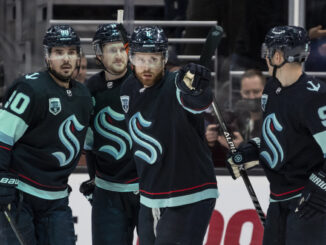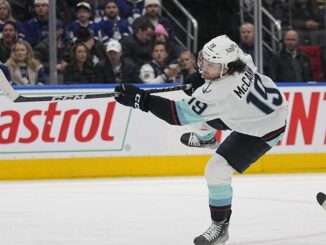
If fans of the Seattle Kraken weren’t paying attention to the year on the calendar, they could be forgiven for thinking that they were re-living the summer of 2024.
After failing to qualify for the playoffs for the second consecutive season, the Kraken relieved Dave Bylsma, who had only been hired last summer, of his duties and again needs a new bench boss. On the draft front, the recent 2025 NHL Draft Lottery results mean that, just as in last year’s draft, the Kraken will pick eighth overall.
If the Kraken’s circumstances seem familiar, it’s because they are, but their activity at the trade deadline indicates at least a partial commitment to a rebuild or retooling of the roster.
The NHL also recently announced that the salary cap is scheduled to be $95.5 million next season, and could rise to as high as $113.5 million for the 2027-28 season. It’s with that backdrop that we move into the team’s list of unrestricted (UFA) and restricted (RFA), most of whom should return for the 2025-26 season. Only players who have played at least 41 games in the NHL this season are listed.
Ryker Evans, Defenseman (RFA)
2024-25 Statistics: 73 Games Played (GP) – 5 Goals (G) – 20 Assists (A) – 25 Points (PTS)
Evans performed well in his first full NHL season, but is seemingly stuck behind Vince Dunn and Brandon Montour on the blue line depth chart. He still ranked fourth among the Kraken’s defensemen in average ice time in all situations (19:29 minutes per game) but is the clear third option on the power play where both Dunn (2:29) and Montour (2:26) eclipsed Evans’ relatively meager usage (less than a minute per game).
Evans is a prime target for an offer sheet given his situation and the NHL’s compensation thresholds for this offseason. If Evans signed an offer sheet worth between $2.34 and $4.68 million annually, the offering team would only have to send the Kraken a second-round pick in exchange. In a rising cap world, that is a very small price to pay for a young defenseman who has shown the ability to both man the power play in Dunn’s absence and play top-four minutes. One only has to look to the St. Louis Blues just this season to see a very rare case (or two!) of a successful outcome when it comes to offer sheets.
Evans still has four years left with RFA status and is not arbitration eligible at the moment, which means that unless he is frustrated with his ice time and signs an offer sheet, a bridge deal of two to three years is the most likely outcome. Given that the cap should be exponentially larger by the summer of 2027, a deal ending prior to that offseason makes complete financial sense. Evans has hopefully become at least the Kraken’s third-most important defender and could have two more seasons of evidence to lean on in contract talks.
Such development would warrant a massive extension, so expect a two-year deal worth just under $3 million annually for Evans.
Kaapo Kakko, Forward (RFA)
2024-25 Statistics: 79 GP – 14 G – 30 A – 44 PTS
Kakko is an RFA this summer but, unlike Evans, is arbitration eligible and could become a UFA next summer; therefore, angling for a longer and more expensive extension. Given how his career trajectory has changed since being acquired from the New York Rangers partway through this past season, Kakko signing an offer sheet seems very unlikely.
Though he has yet to hit the heights expected of a typical second-overall pick, Kakko flashed the tantalizing combination of size and skill that made him so highly touted in the first place. The Finnish winger scored at a 16-goal, 50-point pace over 49 games after the trade, and looked much more comfortable in a new environment. Kakko saw a massive jump from the 13:17 minutes per game he saw with the Rangers to the 17:03 minutes per game in Seattle and finished fifth among Kraken forwards in average ice time.
While that production is reassuring, it makes the terms of Kakko’s next contract that much more uncertain. Kakko could leverage his arbitration eligibility and push for a one-year deal which would take him to unrestricted free agency next summer. He’s 24, and another full season in the top six could see him set new career highs that he could parlay into a long-term deal that takes him through his prime.
You may also like:
- Seattle Kraken Should Target These 5 Players At The 2025 NHL Draft
- Seattle Kraken Should Consider 5 Coaching Candidates To Replace Bylsma
- Seattle Kraken – 4 Keys To A Successful 2025 Offseason
- 3 Reasons Why The Seattle Kraken Missed The 2025 NHL Playoffs
If the Kraken believe in Kakko’s potential and don’t mind paying a slightly higher price, a deal in the realm of Eeli Tolvanen’s two-year contract worth $3.475 million per year could provide the blueprint as a first-round pick himself with a career path that has mirrored Kakko’s to date. Tolvanen was coming off a season in which he set a new career high in points (41) and rewarded Seattle’s belief in him with a new career-best of 23 goals this past season.
Tolvanen signed for about four percent of the cap for two years, but Kakko has both a higher pedigree as a top-three pick and a higher career benchmark in points than Tolvanen at the time of his extension. Assuming a commitment of at least five to six percent of the cap, a five-year deal worth $5.5 to $6 million annually could be in the cards for Kakko, which would also allow him to be a free agent before 30.
Tye Kartye, Forward (RFA)
2024-25 Statistics: 63 GP – 6 G – 7 A – 13 PTS
While Kartye has struggled to replicate the heights of his NHL playoff debut in 2023 (three goals and five points in 10 games) and 11-goal rookie season, his physicality (first on the team in hits per-60-minutes) and age (24) should entice the Kraken to keep him in the fold.
Kartye only tallied 13 points last season and was sent to the AHL for a successful conditioning stint (he scored four points in three games), but he seems to find his footing towards the tail end of the year and should be a frontrunner for a regular bottom-six role given his NHL experience compared to the rest of the candidates.
Kartye’s energetic and physical style stands out among the Kraken’s young players under age 25, with a conveyor belt of talented forwards set to graduate into AHL and NHL duty over the next few seasons. That unique skill set combined with his youth could see Kartye and the Kraken reach a compromise where he gets a slight raise ($1 to $1.5 million) and some security (two to three years), but doesn’t put the Kraken on the hook long term if he doesn’t develop a more reliable scoring touch.
Mikey Eyssimont, Forward (UFA)
2024-25 Statistics: 77 GP – 9 G – 7 A – 16 PTS
The Kraken have eight forwards under contract for next season who played at least 41 games for the team in 2024-25, and two others (Kakko and Kartye) who are RFAs and likely to re-sign. That leaves two regular spots with Eyssimont battling with NHL journeymen in Mitchell Stephens (28 games played) and John Hayden (20), as well as the Kraken’s up-and-coming prospects in Ryan Winterton and Jani Nyman.
Those two earned late-season call-ups and should be at the front of the line for a permanent spot, with Logan Morrison (42 points in 72 AHL games) and Jagger Firkus (36 in 69) further down the ladder but also in consideration for one of the 12 forward slots.
Eyssiomont was part of the return in the Oliver Bjorkstrand and Yanni Gourde trade at the trade deadline, and only played 10:25 minutes per game across his 20-game stint. He might still return as injury insurance, but for around league minimum on a short-term deal, as he doesn’t figure into Seattle’s long-term plans.
Josh Mahura, Defenseman (UFA)
2024-25 Statistics: 64 GP – 0 G – 9 A – 9 PTS
Mahura is a depth defenseman who was signed as a free agent after two seasons with the Florida Panthers. He was mostly a bit-part player as he didn’t play a single playoff game during their Stanley Cup-winning campaign last season, but he played in all 21 of their playoff games as they lost in the 2024 Stanley Cup Final to the Edmonton Oilers.
An injury to Vince Dunn and the trading of Will Borgen opened up a regular spot on Seattle’s blue line for Mahura, but he only tallied nine points in 64 games and hovered around 45% in terms of the Kraken’s share of chances and expected goals when he took the ice at five-on-five.
The Kraken don’t have many highly-rated defensive prospects in their system, but one or both of Ville Ottavainen (15 points in 66 AHL games) and Ty Nelson (29 in 69) could challenge for a third-pair role next season and make Mahura redundant at the NHL level. I don’t expect him to return next season, but I wouldn’t be surprised if he is back on a league-minimum salary as injury insurance.
2025 Offseason a Turning Point for the Kraken
At the end of last season, I noted that the 2024 and 2025 offseasons would represent the most significant period in the Kraken’s brief history as an organization. While the Kraken delayed the inevitable and pushed the much-needed retool until the 2025 Trade Deadline, the direction they are taking seems much clearer now.
The rising cap gives the Kraken a ton of flexibility as they rid themselves of expensive contracts handed out to veterans over their first few years of existence. The 2026 offseason could see one or more of Jaden Schwartz ($5.5 million), Jordan Eberle ($4.75 million), and Jamie Oleksiak ($4.6 million) become UFAs, clearing up nearly $15 million in cap space between those three alone.
While another season or two of losing seems to be in the cards for the Kraken, knowing that the front office has a coherent plan and is embracing the future is reassuring for the fan base. There is more work and more suffering before the Kraken achieve the goal of being a Stanley Cup contender, but the state of affairs in Seattle appears much more positive than it did a year ago.
Data courtesy of Natural Stat Trick and the NHL.




